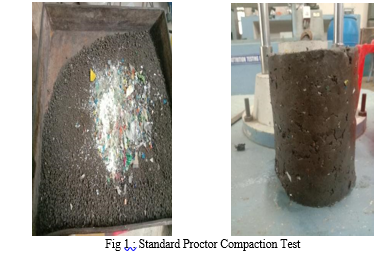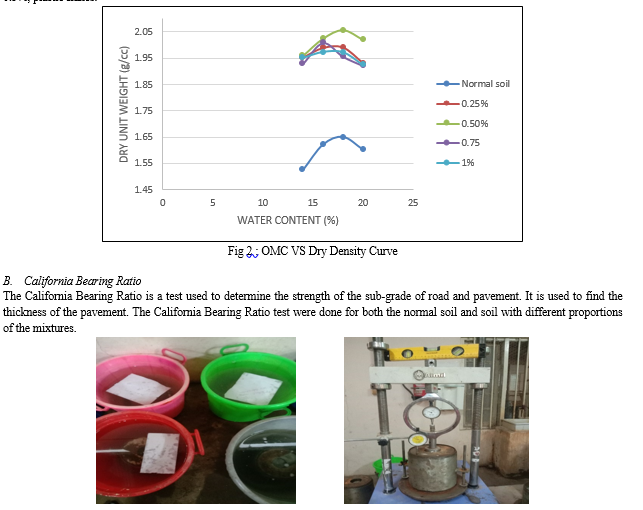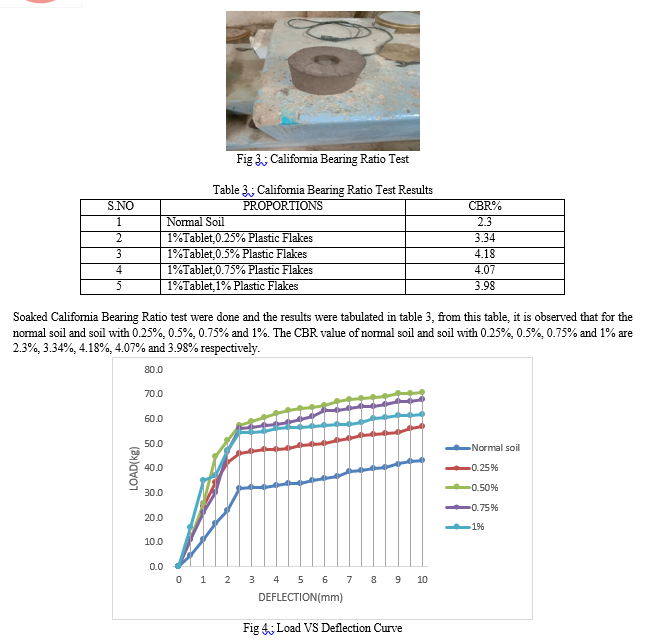Ijraset Journal For Research in Applied Science and Engineering Technology
- Home / Ijraset
- On This Page
- Abstract
- Introduction
- Conclusion
- References
- Copyright
Experimental Analysis on the Stability of the Soil Using Medical Waste
Authors: N. K. Mahaa Lakshmi, M. Kumar
DOI Link: https://doi.org/10.22214/ijraset.2023.54337
Certificate: View Certificate
Abstract
Due to pandemic and other health care activities, there is an increase in generation of Medicine and Medical waste also Out of which 85% of Hospital waste disposed are general non-hazardous waste that can be recycled and reused. On the other hand, there is a need in increasing the strength of the sub-grade economically. Therefore attempts has been made to recycle the medical waste and are used as a soil stabilizer material to increase the strength of the sub-grade. In this project, Medical waste such as Plastic flakes and Expired tablets are used as a stabilizer. The effect of stabilization using these materials were evaluated by carrying out standard laboratory tests. The tests have been done for both natural soil and stabilized soil with a combination of 1% of expired medicine (GLIMI DM PLUS) with different proportion of plastic flakes such as 0.25%, 0.5%, 0.75% and 1%. A series of Standard proctor compaction test and Soaked California Bearing ratio test were done for both natural soil and soil with stabilizers. The test results shows that there is an improvement in the strength of the soil when adding medical waste and furthermore increase in the proportion of the medical waste causes gradual decrease in the strength of the soil. Thus adding medical waste at a certain amount increase the stability of the sub-grade.
Introduction
I. INTRODUCTION
The permanent physical and chemical modification of soils to improve their physical characteristics is known as soil stabilization. From expansive clay to granular solids, stabilization can be utilized to treat a variety of sub-grade materials. Stabilization can boost a soil's shear strength and manage its shrink-swell characteristics, improving the sub-grade's ability to support foundations and pavements. Roads are becoming a crucial component of national growth. However, this cannot meet the criteria for a cost-effective road construction due to the appropriateness of the soil. So to maximize the strength of the soil sub-grade, adequate soil treatment is necessary. Stabilized soil is more resilient and beneficial for road building by reducing the thickness of pavement and also controlling the shrink and swell properties of soil, which assists in creating better soil gradation. On the other hand the proper disposal of waste is increasingly important for most nations worldwide. Large-scale generation of these waste products is having an adverse effect on the environment and the economy. Due to 2 pandemic and other health care activities, there is an increase in generation of Medicine which also leads to increase in medical waste . Nearly 550 tons of medical waste are produced in India every day, it is necessary to recycle this garbage. Out of which 85% of Hospital waste disposed are general nonhazardous waste that can be recycled and reused. Medical waste is challenging to dispose of and requires special techniques that are expensive. As a result medical waste are used as stabilizing material. When properly sterilized, it may be used in building without risk. Plastic is a substance that is renewable and not biodegradable, bearing the strength of soil. Plastic trash disposal contributes to environmental contamination. Plastic can be reused, recycled, or processed again to create certain valuable goods. Plastic waste can be added to stabilize soil as an additive. In this project non-hazardous medical waste are used to stabilize soil. The experiment has been done in order to increase the strength properties of the soil and are tested with a constant proportion of expired medicine and various mixing ratios of plastic flakes. The engineering qualities of the soil, are found out by Standard proctor compaction test and California Bearing Ratio Test. Tests are carried out on the natural soil sample first, and then on the soil that has been mixed in various ratios with medical waste. The most crucial of these studies is to give the optimum ratio of mixing that gives the soil the most strength and may be utilized as a standard mix for increasing the sub-grade strength.
A. Objective
The main objectives of this study are as follows as,
- To evaluate the Index and Engineering properties of the treated soil and untreated soil.
- To determine the optimum percentage of additive for increasing the strength.
II. MATERIALS AND METHODS
A. Soil
The soil was collected from the GCT campus, Coimbatore. It is extracted at a depth of 2m below the ground level to avoid top soil. There is no organic content found in the soil. According to the Indian Standard Soil Classification System, the soil is classified as clay of medium compressibility (CI).
B. Plastic Flakes
The plastic flakes used in this study is obtained from Medical waste recycling center after treatment. The plastic flakes which passes through 4.75mm sieve is used in this study. Plastics improve the strength characteristics of the soil. It is also used to improve the foundation layer of the pavement.
C. Expired Medicines
The expired tablets used in this study is the Glimi DM plus Tablet SR which is a member of the anti-diabetic medicament class of medications. For the treatment of type 2 diabetes mellitus in adults, it combines two medications. Diabetes sufferers benefit from improved blood sugar management. The ingredients present in the tablet includes Lactose, Sodium starch glycolate, Povidone, Micro-crystalline and Magnesium Stearate. Magnesium stearate C36H70MgO4 is generally used to improve the inter-molecular friction. It also increases the flow ability and compact ability characteristics. The optimum amount of magnesium stearate to be added is 1% to the weight of the soil.
III. METHODOLOGY
The soil samples were collected from Government College of Technology, Coimbatore. The basic test of soils like Grain size Distribution, Atterberg test, Specific gravity test were done for the soil samples and the soil was classified as CI that is the clay of intermediate compressibility. Medical waste in the plastic forms were collected from medical waste recycling center and the expired medicines were brought from nearby medical shops. The Standard Proctor Compaction Test were done for untreated soil and soil treated with 1% expired medicine and 0.25, 0.5, 0.75 and 1% of medical waste plastic flakes passing through 4.75mm sieve. The test results were obtained. Similarly CBR test were also done to the untreated soil and the soil with 1% expired medicine and 0.25, 0.5, 0.75 and 1% of medical waste plastic flakes passing through 4.75mm sieve. Both the test results were compared and the results were concluded.
IV. LABORATORY INVESTIGATION
A. Specific Gravity
The specific gravity of the clay is determined as per IS: 2720 (Part 3/sec1)-1980. Three trails of specific gravity test were done and the average of the values are taken. The specific gravity of the soil is found to be 2.71.
B. Grain Size Distribution
The grain size distribution of the soil is done by conducting wet sieve analysis test. The tests were conducted as per IS: 2720 (part 4)-1985.
C. Atterberg Limits
Liquid limit, Plastic limit test were done as per IS: 2720. The soil are classified based on the plasticity chart.
D. Standard Proctor Compaction Test
The optimum water content and maximum dry density is obtained by conducting Standard Proctor Compaction Test as per IS: 2720 (Part 7) - 1980. The relation between moisture content and dry density is obtained from compaction test.
E. Unconfined Compressive Strength Test
The Unconfined Compressive Strength and Cohesive Strength is obtained by conducting Unconfined Compressive Strength Test. The test were conducted as per IS 2720 (Part 10): 1991.
The relation between stress and strain obtained as a result of Unconfined Compressive Strength Test is given below:
Table 1 : Geotechnical Properties Of Natural Soil Sample
|
S.NO |
PROPERTIES |
VALUE |
IS METHOD |
|
1 |
Specific Gravity |
2.71 |
IS:2720(Part-III) |
|
2 |
Grain Size Distribution
|
0 38.81 61.19 16.096 0.222 |
|
|
3 |
IS Classification |
CI
|
IS2720(Part-IV) |
|
4 |
Atterberg Limit
|
40.6 23 18 |
IS:2720(Part-V) |
|
5 |
Optimum Moisture Content (%) |
18 |
IS:2720(Part-VII) |
|
6 |
Maximum Dry Density (g/cc) |
1.65 |
IS:2720(Part-VII) |
|
7 |
Cohesive Strength |
0.0204 N/mm2 |
IS:2720(Part-X) |
|
8 |
Unconfined Compressive Strength |
0.040 N/mm2 |
IS:2720(Part-X) |
|
9 |
Free Swell |
45.45% |
|
V. RESULTS
A. Standard Proctor Compaction Test
The Standard Proctor Compaction Test is used to find the optimum moisture content at which the soil reaches its maximum dry density and becomes dense. Standard proctor Compaction Test were done by adding different proportions of plastic and expired medicines. The optimum water content and maximum dry density were noted for different proportions and the results are tabulated. From the results the graphs are plotted for optimum moisture content and maximum dry density.

Table 2 : Standard Proctor Compaction Test Results
|
S.NO |
PROPORTIONS |
OMC (%) |
DRY DENSITY (g/cc) |
|
1 |
Normal soil |
18 |
1.65 |
|
2 |
1% Tablet, 0.25% Plastic Flakes |
18 |
1.991 |
|
3 |
1% Tablet, 0.5% Plastic Flakes |
18 |
2.056 |
|
4 |
1% Tablet, 0.75% Plastic Flakes |
16 |
2.008 |
|
5 |
1% Tablet, 1% Plastic Flakes |
16 |
1.973 |
From table 2 it is seen that the OMC of normal soil is 18% whereas the OMC of the soil when mixed with 0.25%, 0.5%, 0.75% and 1% of Plastic Flakes at 1% constant expired medicines are 18%, 18%, 16%, 16% respectively. Similarly the maximum dry density of the normal soil and soil with 0.25%, 0.5%, 0.75% and 1% were 1.65g/cc, 1.991g/cc, 2.056g/cc, 2.008g/cc and 1.973g/cc respectively. The optimum moisture content and maximum dry density was obtained for soil mixed with 1%, expired medicine and 0.5%, plastic flakes.


VI. DISCUSSIONS
Generally the results shows that with the increase in the inclusion of plastic flakes in the soil the OMC remains constant and gradually decrease. This is because the magnesium stearate is highly compatible in nature and plastic is non-absorbent when compared to clay soil which is a very good absorbent due to its surface tension. Regarding the maximum dry density, the MDD increases up to 0.5% and decreases gradually, this may be due to high compact ability characteristics of the Magnesium stearate present in the expired tablet. The optimum CBR value is found to be 4.18% obtained for soil mixed with 1% Magnesium stearate and 0.5% plastic flakes. And further increase in the addition of plastic flakes that is 0.75% and 1% the optimum moisture content and dry density decreases which also leads to the reduction of CBR %.
Conclusion
The research investigate the effects of adding medical waste such as plastic flakes and expired tablets at definite proportions, the results from the research are as follows. The soil is mixed with 4 proportions of plastic flakes and a constant proportion of expired tablet. The results of natural soil and soil when mixed in 4 proportions were compared. From the standard proctor compaction test the optimum moisture content and maximum dry density observed were 18% and 2.056g/cc respectively which is higher than the natural soil. The optimum CBR percentage is 4.18 %. The optimum proctor result and the CBR results were found for soil with 1% Expired tablets and 0.5% of plastic flakes which is also higher than natural soil. Therefore it can be concluded that 1% tablet and 0.5% plastic flakes can be used as the optimum values. Further increase in the addition causes decrease in the strength of the sub-grade.
References
[1] Asefachew Belete Tseganeh,” Stabilization of Expansive Soil Using Biomedical Waste Incinerator Ash”, Journal of Management Science & Engineering Research. [2] Dhanya Jaya,Meera Varghese,” Soil Stabilization using Raw Plastic Bottles” Proceedings of Indian Geotechnical Conference. IOP Conf. Series: Earth and Environmental Science 614 (2020) 012082. [3] Gotham, Naveen Kumar, Ranjithkumar, Vijayakumar, Siva raja,” Stabilization of clay soil by using glass and plastic waste powder”, International Journal of Engineering and Techniques. Construction and Building Materials 234 (2020) 117271. [4] Hussein Jalal Aswad Hassan, Jabar Rasul, Maleaha Samin,” Effects of Plastic Waste Materials on Geotechnical properties of clayey soil”. [5] Idris Azni, Saed Katayon, Muniandy Rathnasamy,” stabilization and utilization of hospital waste as road and asphalt aggregate”. J Mater Cycles Waste Management. Year-2005,Pg NO.33–37. [6] Kishore K, Manickavasagam R.,” Stabilization of Black Cotton soil using Medical Waste”. International Journal of Engineering Research & Technology (IJERT), Vol. 10 Issue 05, May-2021. [7] Nathalia dos Santos lopes louzada., Jose Adriano Cardoso Malko., Michele dal toe Casagrande.,(2018).”Behaviour of clayey soil reinforced with polyethylene terephthalate”, Journal of materials in civil engineering.2019, 31(10): 04019218. [8] Rohin Kaushik, Tarun Sharma,” Influence of waste polypropylene fibers on Resilient Modulus of clay soil”, International Journal of Research in Advent Technology, Vol.7, No.1, January 2019,E-ISSN: 2321-9637. [9] Tarun Kumar, Suryaketan Panda, Shayeque Hameed and Joyanta Maity,” Behaviour of soil by mixing of plastic strips”, International Research Journal of Engineering and Technology,Volume: 05 Issue: 05 | May-2018.
Copyright
Copyright © 2023 N. K. Mahaa Lakshmi, M. Kumar. This is an open access article distributed under the Creative Commons Attribution License, which permits unrestricted use, distribution, and reproduction in any medium, provided the original work is properly cited.

Download Paper
Paper Id : IJRASET54337
Publish Date : 2023-06-22
ISSN : 2321-9653
Publisher Name : IJRASET
DOI Link : Click Here
 Submit Paper Online
Submit Paper Online

